
Looks like OnePlus is not going to give any special treatment to the Indian audience after its OPPO merger. Why? Because, the OnePlus 10 series has already launched in China and we are only now getting the OnePlus 9RT. Anyway, the phone’s here and for my very first gadget video on Trakin Tech English I’m going to be doing an in-depth review of the 9RT and compare it against the Galaxy S21 FE along the way. Let’s find out if the phone is still relevant in today’s market.
Contents
Design
Before I start talking about the design of the 9RT, I must say that OnePlus doesn’t skimp on the box contents. You get a case, a 65W fast charger, Type-A to Type-C cable, and a bunch of stickers too. Oh yeah, there’s also a pre-attached screen protector. In comparison, Samsung only gives you a Type-C to Type-C cable inside the box.
Now, the design of the 9RT is very similar to the entire OnePlus 9 series. You get the same glass sandwich design with Corning’s Gorilla Glass 5 on the front and the back. Nothing extraordinary really. But, I do like this unique Hacker Black colour variant which has a glimmery back, which resembles a starry night. It has a nice smooth finish and doesn’t attract fingerprints either.
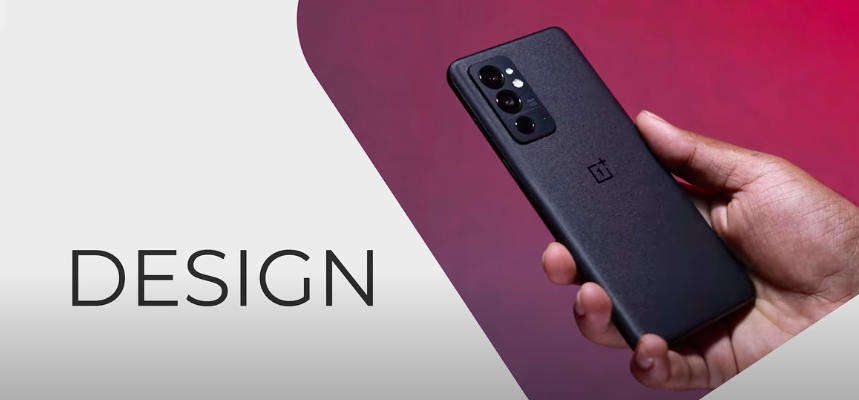
The in-hand feel is good too, thanks to the curved back. However, since the Galaxy S21 FE is made entirely of plastic, it is definitely lighter, and therefore, more comfortable to hold. Moving on, the camera does protrude from the back making it wobble on a table. As for the ports, you get your standard Type-C port with USB 2.0 speeds at the bottom. Alongside which is a speaker grille, which works in tandem with the earpiece to work in stereo setup.
The stereo speaker setup sounds impressive as usual. Here’s a side-by-side comparison against the Galaxy S21 FE’s stereo speaker setup for comparison. The OnePlus 9RT definitely sounds louder and fuller.
While there is no 3.5mm jack, you do get support for Dolby Atmos and it works with Apple Music too. I had a blast listening to The Weeknd’s latest album Dawn FM in Spatial audio using the Shanling UA2 and the Moondrop Blessing 2.
Overall, the 9RT doesn’t take any risks and plays it safe…just like the Samsung Galaxy S21 FE. Both are similar in design to their previous iterations.
Display
For some odd reason, OnePlus has bumped up the size of the display from 6.55-inches on the 9R to 6.62-inches on the 9RT. This is an E4 Fluid AMOLED panel with support for Display P3 colour gamut. For the display purists out there, OnePlus has added a new Cinematic mode which offers a fantastic colour accurate display. I used the phone only in this mode.
The phone also offers a local peak brightness of nearly 1300 nits, which further enhances your experience while watching HDR videos on supported apps like YouTube and Netflix. And yeah, Netflix does offer HDR playback.
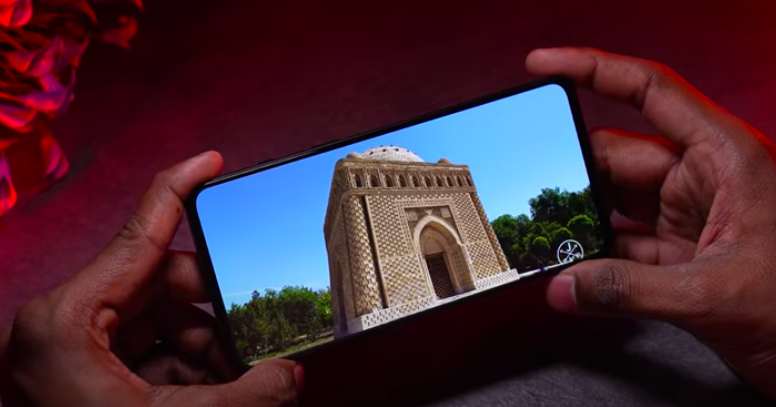
Apart from this you get a super fast 120Hz refresh rate, which is tuned fantastically. Couple that with the 300Hz touch response rate, you get rapid responses as well. Furthermore, using the Game Tools plugin, you can increase the touch response rate to 600Hz. This reduces the latency from 36ms to 29ms. I immediately noticed an improvement in performance. But, to be honest, this is nothing new. We have many phones with high touch sampling rates now, of which the iQOO 7 continues to be my favourite till date.
OnePlus claims an improved haptic feedback but I didn’t find it any better. In fact, the Nord 2 has a tighter tuning. As for the in-display fingerprint scanner, it continues to be blazing fast.
Software
Oddly, the OnePlus 9RT runs on Oxygen OS 11.3 based on Android 11. Moreover, the phone has the November security patch. OnePlus used to be always ahead of the curve when it comes to software up2dates, but not anymore. And, by now, we’ve established that Oxygen OS is starting to resemble Color OS a lot and that hasn’t gone down well with the long time fans. This is not to say that Oxygen OS is bad because it has some genuinely useful features such as Zen mode and Shelf, and it is very well optimised with the hardware as well.
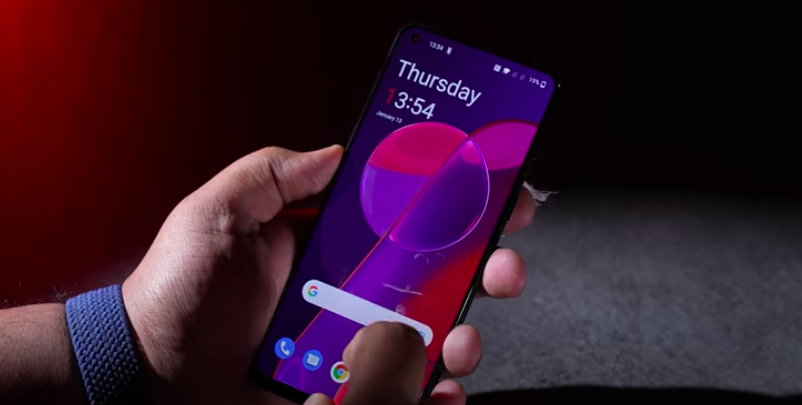
All that’s said, other brands have caught up with clean implementation of software and the Samsung Galaxy S21 FE runs OneUI 4.0 based on Android 12. *Editor note: insert “Oh how the turn tables” office meme*
This clearly shows that Samsung is doing a better job here.
Camera
Coming to the cameras on the phone, the OnePlus 9RT has a Sony IMX 766 50MP primary camera sensor, which OnePlus had used on the OnePlus 9 Pro’s ultrawide if you remember. The secondary is a 16MP ultrawide and the final camera is a 2MP macro. On the front, you get a 16MP selfie camera. On paper, this is a decent setup but the Galaxy S21 FE has an ace up its sleeve in the form of its 3x telephoto shooter. I tested the cameras side-by-side and here’s what I found out.
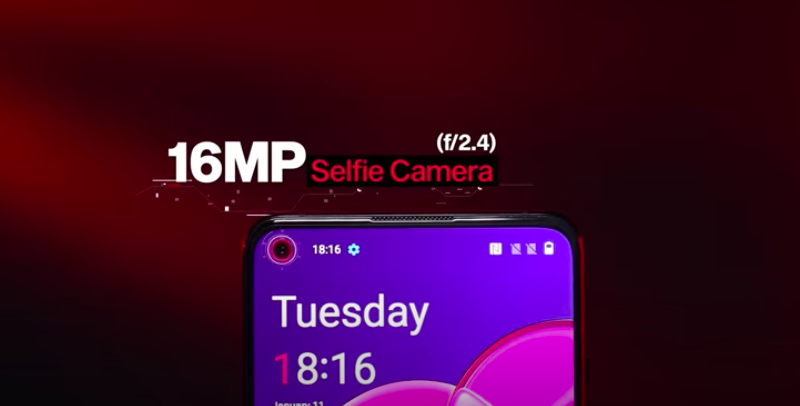
- What I noticed first was the 12MP pixel binned samples from the OnePlus 9RT and the basic 12MP captures from the S21 FE are equally sharp around the center. But yes, the corner sharpness is slightly better on the 9RT. Most general users won’t really care though. These are very minute differences. Prima facie you get a similar level of detail retention from both the sensors.
- As for the dynamic range performance, the Galaxy S21 FE offers a far better control over the highlights. You can see that the highlights are blown out in the OnePlus 9RT sample. But yes, the 9RT does bring out slightly more details from the darker shadow regions. Overall, I’d pick the S21 FE for dynamic range.
- On the contrary, the colour reproduction is better on the OnePlus 9RT. Especially in the first sample, where you can see a cooler colour temperature on the white car in S21 FE’s sample. In the second sample, the Reds are more accurate on the OnePlus 9RT.
- The ultrawide camera sample is much sharper on the 12MP S21 FE in comparison to the 16MP unit inside the OnePlus 9RT. Further proving the theory that megapixels don’t matter.
- And, while the 9RT has a dedicated macro camera, it is only a 2MP unit. I used the 3x telephoto on the S21 FE to match the capture and the camera obliged with a tack sharp focus. You get a much detailed macro as a result. Which proves my theory that a good telephoto is always better than a dedicated macro camera.
- In this shot of Arun, you will see that the 9RT captures a very warm image where the facial tones and the colour of the shirt is off. Samsung really does a bang up job of capturing the right facial tone. Yes, it is not as detailed as the 9RT but I am sure anyone would gravitate towards the S21 FE here.
- In portrait mode, the Galaxy S21 FE has an advantage because it can also shoot portraits using the 3x optical zoom camera. Therefore, you get a more accurate size of the face because of the 76mm focal length. Also, portraits look way better on the S21 FE by default. You get much better facial tones and the dynamics of the overall image is better too.
- Unequivocally, whether you are shooting in even light or against the light, the S21 FE’s selfie camera captures sharper selfies with very accurate facial tones. Just take a look at these samples to judge for yourself.
- The same is true for selfie portraits as well. The S21 FE easily takes better, more usable shots.
- Considering the great performance of the Galaxy S21 FE until now, I expected the camera to be better in low light too. However, the OnePlus 9RT handily beats it. Granted, the images do look over-saturated but they aren’t as flat as the Galaxy S21 FE, which looks extremely dull and lifeless. Plus, you get much sharper details in the S21 FE samples, whether in low light or with Night Mode turned on. Oh also, I forgot to mention, the lens attached to the 9RT’s main camera is much wider compared to the Galaxy S21 FE.
- The same is true for the low light ultrawide samples. The OnePlus 9RT is just better.
- That said, low light selfies look crisper on the Galaxy S21 FE. The OnePlus 9RT does catch up when Night Mode is turned on but it still cannot top the Galaxy S21 FE.
- Both the phones can shoot 4K 60fps video with stabilisation. And, both the footages here are equally detailed and sharp. Although, the S21 FE is definitely better at colour reproduction, dynamic range performance, and sound quality.
- You also get an extra-stable mode on both the phones. The Galaxy S21 FE uses electronic image stabilisation for a tighter crop of the footage. While it is definitely more stable, it has the distinctive jellying effect when you pan fast. The 9RT has a much wider frame but it doesn’t offer a great stabilisation, therefore nullifying the whole reason for this mode.
- And finally, when it comes to the videos from the front camera, the S21 FE, by virtue of the fact that it can shoot 4K 60fps videos, just beats the OnePlus 9RT easily. The results are there for you to see.
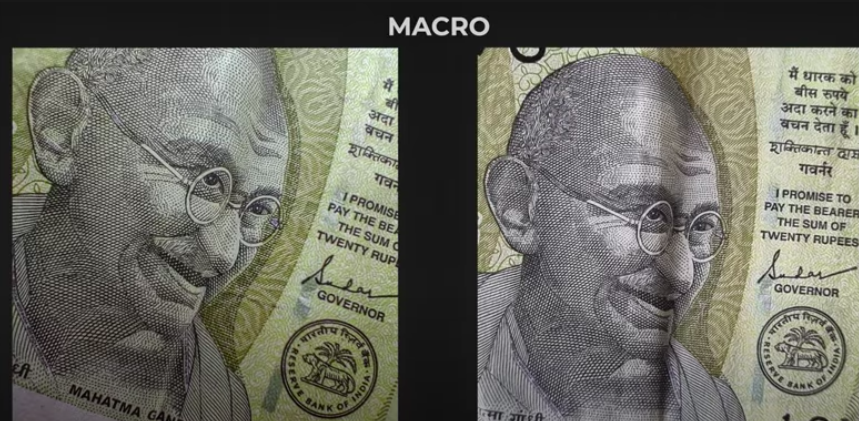
The OnePlus 9RT’s overall camera performance is not too shabby but when pitted against the S21 FE it loses out in many aspects. The only assertive win for the 9RT’s cameras is in its low light performance. So, you will have to strongly identify your use case accordingly before you make a decision.
Performance and Network
If there is one thing the OnePlus 9RT aces is the performance. You get the one generation old Snapdragon 888 SoC and our unit is the 12GB, 256GB variant. Yup, and it’s LPDDR5 RAM and UFS 3.1 storage as expected. I don’t even have to say it anymore, in daily usage the phone just flies. And, the benchmark scores, whether it is AnTuTu or Geekbench or 3DMark, are better on the OnePlus 9RT with SD888 compared to Exynos 2100 inside the Galaxy S21 FE.

More importantly, though – thanks to the improved vapour cooling chamber – the phone runs cool. I ran the intensive 3DMark Wild Life Stress Test and the phone only touched a max of 42 degrees as opposed to 45 degrees on the Galaxy S21 FE. Plus, I played Call of Duty for 1 hour at a stretch and it didn’t cross 42 degrees. Oh yeah, you can expect every single game to run butter-y smooth. OnePlus has really upped the ante with gaming.
Couple that with the new Pro Gaming mode with Advanced DND and ultimate mistouch prevention that Blocks even the access to Game Tools. This is the one thing I miss while playing on an iPhone – a dedicated gaming mode.
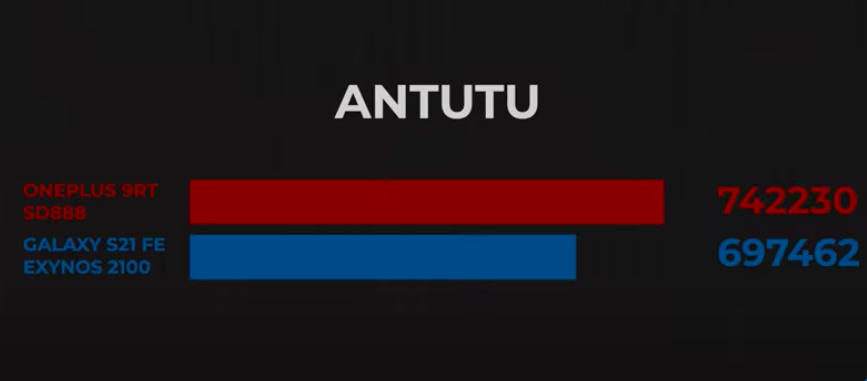
As for the network performance, you get support for 8 5G bands and 4G+ carrier aggregation as well. The call quality was fantastic and OnePlus has also improved the Wi-Fi reception quality by using triple antennas. Plus, there is support for Wi-Fi 6 as well. The 9RT ticks all the right boxes when it comes to network performance.
Battery Life
The OnePlus 9RT has a 4500mAh battery and 65W charging as well. But, there’s no wireless charging. The phone easily lasts more than a day on single charge and the battery life is better than the Galaxy S21 FE. You can expect about 6hrs of Screen on Time, which is great for a phone with Snapdragon 888. Also, it takes only 30 minutes to charge from 0 to 100. In the battery department the OnePlus 9RT just rules.
Conclusion
The OnePlus 9RT is expected to start at around Rs 40,000. And, at that price, I’d say it is definitely a good upgrade over the OnePlus 9R. Any more, and then it becomes contentious.
Anyway, the 9RT is made for gamers and performance enthusiasts. So, don’t expect the cameras to be great. Except for Night Mode, where it does a good job. You can consider it but I’d say wait for the Xiaomi 11T Pro too.
And, if you can spend 10k more, and don’t care about raw performance as much, the Galaxy S21 FE is a well-rounded phone with a better set of cameras, IP rating and wireless charging support. Also, you get OneUI 4.0 based on Android 12 too, which is a win win.
What do you folks think of the OnePlus 9RT, let me know? Will meet you folks in the next one. Keep Trakin and stay safe.

Comments are closed, but trackbacks and pingbacks are open.